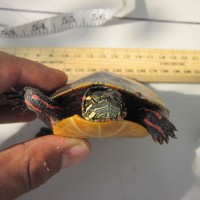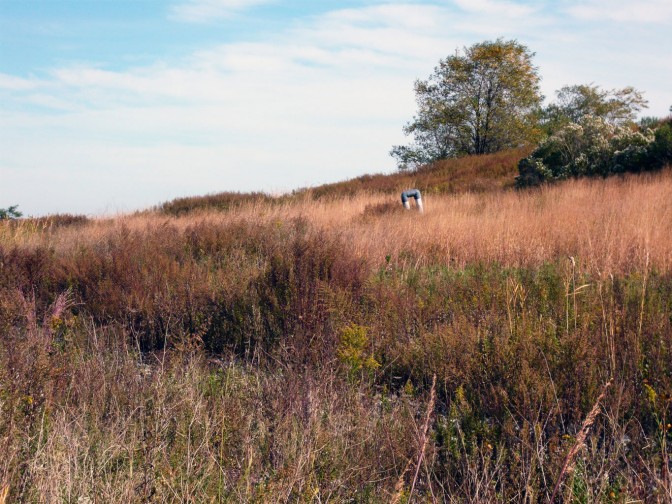Tags: research
Bird Banding Returns to Freshkills Park

Researchers from the College of Staten Island are operating a bird banding station at Freshkills Park for the second consecutive summer. The project is led by Dr. Lisa Manne and Dr. Dick Veit. In 2016, they banded over 20 species of birds, including orchard orioles, hairy woodpeckers, and yellow warblers.
...MOREAmerican Wetlands Month

Did you know that the month of May is dedicated to celebrating the importance of wetlands? Back in 1991, the EPA and its partners designated May as American Wetlands Month to educate Americans about the value of wetlands as a natural resource.
...MORETurtle Research and Water Sampling Indicate Healthy Ecological Progress

Researchers from the College of Staten Island have carried out another successful season of turtle research at Freshkills Park. Since 2012, they have been studying the biodiversity of the park’s ponds with a focus on painted turtles. This comparative study is looking at painted turtle populations in the park’s rainwater basins compared to three other populations around Staten Island.
...MORE2016 in Review

This past year marked the fifteen-year anniversary of the Fresh Kills Landfill closure. In March of 2001, the final barge of household garbage arrived at the landfill. Later that year, the City of New York announced an international design competition for the development of a plan for Freshkills Park.
...MOREThis Holiday Season, Support the Park’s Momentum

Dear Friends:
This year’s $30 million funding for the Mayor’s Anchor Parks initiative is a wonderful recognition of the progress we’re making as Freshkills Park continues to take shape. The Anchor Parks project, now entering design, will focus on South Park.
...MOREBanding Birds to Track Success

This summer, researchers from the College of Staten Island operated the first bird banding station at Freshkills Park. The banding station was part of The Institute for Bird Populations’ MAPS: Monitoring Avian Productivity and Survivorship program, which has been in existence since 1989.
...MORESecret Lives of City Vermin

Ask people to name an animal that lives in New York City, and chances are they’ll pick one of the following: Rats, pigeons, or cockroaches.
And they’ll probably have some horror stories to tell about them.
Now, we could go on and on here at the Freshkills Park office about how there are thousands of different animal species living within the boundaries of NYC, including many that are rare, but today we’d like to take a minute to highlight some aspects of those lesser-loved, often only known for their traits that are in conflict with human society, animals that call NYC home.
...MOREA Look Back at the 2015 Freshkills Park BioBlitz

In 2015, sophomores from CUNY Macaulay Honors College worked with professional scientists across 233 acres and two days in August to conduct a BioBlitz at Freshkills Park. A BioBlitz is a 24-hr biological survey event aimed at developing a snapshot of as much biodiversity as possible in a given area at a particular time of year.
...MOREPanel Discussion: Re-envisioning Post-Industrial Public Landscapes

Freshkills Park’s Manager for Science & Research Development Dr. Cait Field will participate in a panel discussion at Rutgers University on Wednesday, April 27th. Called Re-envisioning Post-Industrial Public Landscapes, the discussion will include panelists from Freshkills Park and Liberty State Park in Jersey City.
...MOREFreshkills Park, Fifteen Years after Landfill Closure

Fifteen years ago this week, the final barge of household garbage arrived at Fresh Kills Landfill. To celebrate this milestone, the website’s new interactive landfill-to-park timeline illustrates almost 100 years of changes in the area.
The last barge to Fresh Kills marked the end of 53 years of landfill operations.
...MOREBirds Count: Winter 2016

On President’s Day weekend, millions of birds were recorded as part of the Great Backyard Bird Count (GBBC). According to the New York Times, this was the 19th year that both amateur and expert ornithologists worldwide have contributed bird sightings to this citizen science project, run by the Cornell Lab of Ornithology, the National Audubon Society and Bird Studies of Canada.
...MORECitizen Science: Water Monitoring Project for Students

This spring, 6th-12th grade students in Staten Island will have the chance to participate in a Citizen Science water monitoring project at Freshkills Park. The project will be overseen by Manager of Science and Research Development Cait Field and fellow NYC Department of Parks and Recreation staff.
...MOREThe Twelve Days of Freshkills Park

12 years since James Corner Field Operations won the City of New York design competition. In 2006, NYC Parks assumed responsibility for implementing the project using Field Operations’ Draft Master Plan as a conceptual guide. The basic framework of the plan integrates three separate systems—programming, wildlife, and circulation—into one cohesive and dynamic unit.
...MOREHighlights from BioBlitz! at Freshkills Park

On August 29th and 30th, Freshkills Park teamed up with CUNY Macaulay Honors College to conduct a BioBlitz of North Park. A BioBlitz is a 24-hr biological survey event aimed at developing a snapshot of as much biodiversity as possible in a given area at a particular time of year.
...MORETweeting Bird Boxes at Freshkills Park

Freshkills Park is developing a unique digital app that will broadcast the ongoing ecological restoration of the Park and create new potentials in the field of scientific research. The launch of the app will highlight a research project investigating the health of the Park’s cavity nesting birds like tree swallows and house wrens.
...MOREFarther Afield: A visit to the Black Rock Forest Consortium

In mid-December, the Freshkills Park Development Team took a trip to visit the Black Rock Forest Consortium in Cornwall, NY. The Consortium manages 3,838 acres of forest with a scientific research field station on site. The team met with Dr. Bill Schuster, Black Rock’s Executive Director, who gave an overview of the facilities at the station and the research and scientific programming taking place, and led the team on a tour into the forest to visit some of the current research sites towards fostering ideas for the future of the scientific research program at Freshkills Park.
...MOREFrom Behind the Mounds: Meet Cait Field, Research Program Manager

From commercially sailing NYC waterways to conducting doctoral research on South American weakly fish, Cait Field brings experience as a scientist, mariner and educator to her new job as the Freshkills Park Research Program Manager. Cait is currently completing a PhD in Neuroscience and Behavior at CUNY Graduate Center.
...MOREIn a Bird Box at Freshkills Park

Three years ago, Professor Mark Hauber from Hunter College hung bird boxes in select locations at Freshkills Park and he has since been monitoring them on an annual basis. He is tracking the growth in the bird population as an indicator of the rejuvenation of the park.
...MOREThe Philanthropic Future of Science?

The NY Times reported that American science is becoming increasingly funded by philanthropic donors, for better or for worse. Supporters of philanthropy cite accomplishments such as medical advances and meeting scientific funding needs in the face of government budget cuts. Others, such as the authors of a Nature editorial, note that philanthropic funding is skewed towards “fashionable” fields such as health, space, and the environment, and is disproportionately allocated to well-known universities.
...MOREBird Breeding at Freshkills
Last week several members of the Freshkills team assisted Dr. Mark Hauber, a professor of Psychology at Hunter College, in checking bird nestboxes in the park. Dr. Hauber is gathering data on the bird populations and breeding success at Freshkills Park, a site which has acted as a stopover for bird species along the Atlantic Migratory Flyway since the closure of the landfill.
...MORE



